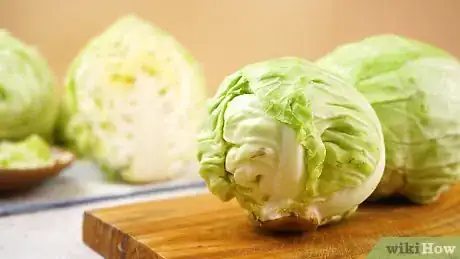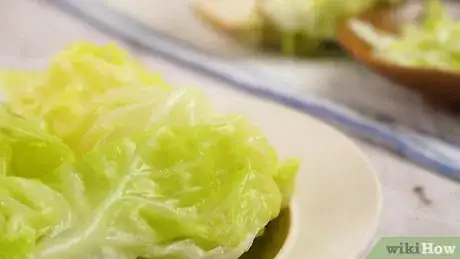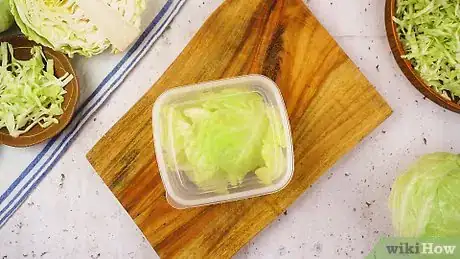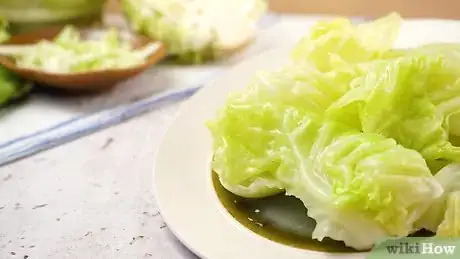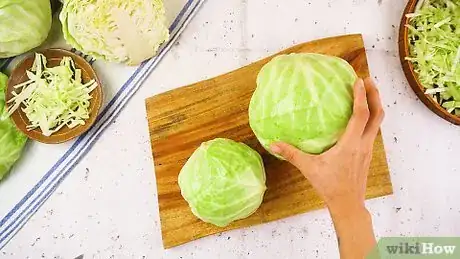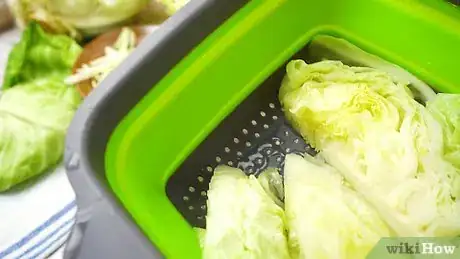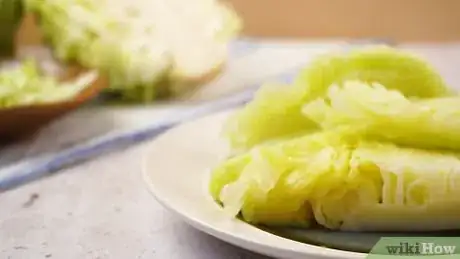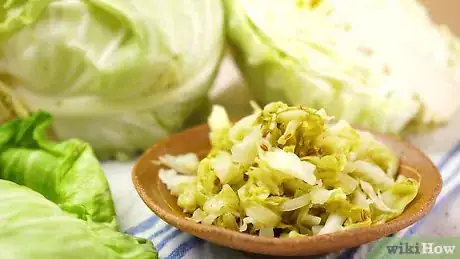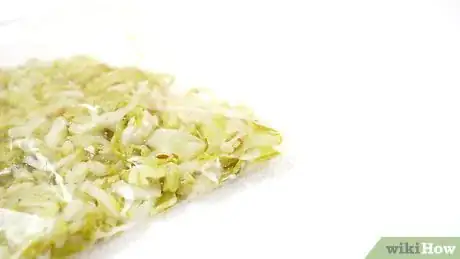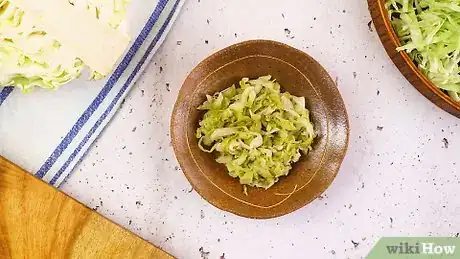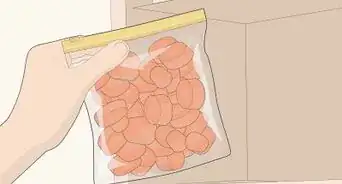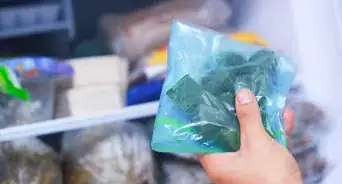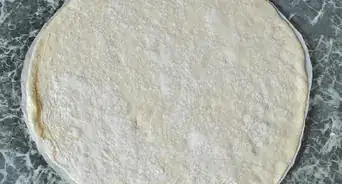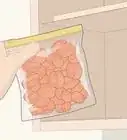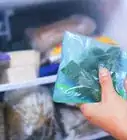wikiHow is a “wiki,” similar to Wikipedia, which means that many of our articles are co-written by multiple authors. To create this article, 11 people, some anonymous, worked to edit and improve it over time.
There are 11 references cited in this article, which can be found at the bottom of the page.
The wikiHow Culinary Team also followed the article's instructions and verified that they work.
This article has been viewed 180,454 times.
Learn more...
While it is possible to freeze cabbage, its structure does tend to break down on freezing. Blanching will help to preserve it better, although it won't be as good as the fresh cabbage. Provided you're okay with that, here is how to freeze a glut of cabbage.
Steps
Whole Cabbage Leaves
-
1Select a suitable cabbage. It should be fresh, clean and without any molding or damage.[1]
-
2Remove the coarse outer leaves. Discard or compost these.Advertisement
-
3Pull the remaining leaves away from the cabbage base. Use a knife to score a cut line at the base, then pull the leaves away intact.
-
4Bring a large pot of water to the boil. Blanch the leaves in this for 1 1/2 minutes. Do this in batches rather than trying to blanch the whole cabbage at once.[2]
-
5Remove and dunk into a bowl of ice water. This stops the cooking immediately.
-
6Drain the leaves. Gently shake off excess water first. Place on absorbent paper or a wire rack to drain.
-
7Pack into resealable bags or a container. Leave room for expansion, about 1.5cm/ 1/2 an inch. Remove as much air as possible if using a resealable bag.[3]
- Alternatively, the leaves can be arranged on a cookie sheet lined with parchment paper, then frozen, then bagged or added to a container.
-
8Seal the container or bag. Label and date the package. Place in the freezer.[4]
-
9Use. The frozen leaves can be added straight in soup, stews and for other cooked dishes. They can also be used for cabbage roll dishes––thaw the leaves in the refrigerator first.
Sliced Cabbage
-
1Select a suitable cabbage. It should be fresh, clean and without any molding or damage.
-
2Remove the coarse outer leaves. Discard or compost these.
-
3Cut the cabbage. Either cut the cabbage into chunky wedges or shred it into medium shreds.
-
4Blanch as for method one. Most likely you will be able to blanch a little more at a time, as there will be more space when the cabbage is cut down.[5]
- If you have wedges, these should be blanched for three minutes.
-
5Drain the blanched cabbage. Place in a colander or similar and allow the excess water to drip off. You can also spread the cabbage on absorbent paper towel to air dry once the excess water has dripped off.[6]
-
6Package and seal as above. You can also use re-boilable bags in place of resealable bags, if preferred.
-
7Use the cabbage. This cabbage can be broken off in chunks or lumps as needed and added to soups, stews, stir-fries, etc. as needed. Add frozen to the cooking dish or thaw before adding. If thawing shredded cabbage for use in coleslaw or stir-fry, thaw in the refrigerator first.
- Note: Not everyone agrees that thawed frozen cabbage works well for coleslaw, as it can turn quite mushy. Be aware that this could happen; if it does, use it in a cooked dish instead.
Freezing Sauerkraut
-
1Use fully fermented sauerkraut only.
-
2Fill pint (600ml) or quart (950ml) size freezer bags or a freezer-proof container with the sauerkraut.[7]
-
3Leave a space at the top of about 1-2 inches (2.5-5cm) to allow for expansion when frozen. If using bags, push gently to expel as much air as possible before sealing.[8]
-
4Seal the bags. Label and date.
-
5Place in the freezer. The sauerkraut will keep for 8 to 12 months frozen.[9]
-
6Use. Thaw the amount wanted in the refrigerator, then use as usual.[10]
Community Q&A
-
QuestionCan I freeze cooked cabbage?
 Community AnswerYes. Cool it after cooking. Place in a freezer bag with the cooking water. Seal airtight, and it should keep for about 6 months.
Community AnswerYes. Cool it after cooking. Place in a freezer bag with the cooking water. Seal airtight, and it should keep for about 6 months. -
QuestionCan I freeze mini cabbage heads?
 Community AnswerYes, you can, but it's best to blanch any vegetable first prior to freezing it. This helps protect the flavor, color, and texture during the freezing process.
Community AnswerYes, you can, but it's best to blanch any vegetable first prior to freezing it. This helps protect the flavor, color, and texture during the freezing process. -
QuestionShould I add salt to my cabbage before freezing it?
 Community AnswerNo. You shouldn't add salt until you are ready to eat the cabbage.
Community AnswerNo. You shouldn't add salt until you are ready to eat the cabbage.
Things You'll Need
- Cutting board and knife
- Cooking pot large enough for leaves
- Bowl of ice water
- Colander
- Absorbent paper towel
- Resealable bag or freezer-proof container
- Marker for labels
References
- ↑ https://www.thekitchn.com/learning-to-love-green-cabbage-66683
- ↑ http://pickyourown.org/cabbagefreezing.php
- ↑ https://www.canr.msu.edu/news/cabbage_and_chinese_cabbage_storage_and_preserving_tips
- ↑ https://www.stilltasty.com/fooditems/index/16658
- ↑ https://www.youtube.com/watch?v=MqCtMW9sJfE
- ↑ https://www.youtube.com/watch?v=MqCtMW9sJfE
- ↑ https://stilltasty.com/Fooditems/index/18272
- ↑ https://extension.psu.edu/lets-preserve-sauerkraut
- ↑ https://extension.umn.edu/preserving-and-preparing/how-make-your-own-sauerkraut
About This Article
To freeze cabbage in whole leaves, start by selecting a clean cabbage and remove the coarse outer leaves. Then, use a knife to score the head of the cabbage, and pull the remaining leaves away from the base. Next, bring a pot of water to a boil, and place the leaves in the water for 1-1.5 minutes. After a minute or so, remove the leaves from the water and put them in an ice bath immediately. As the leaves cool, place them in a colander to dry, then transfer them to sealable plastic bags. Place the bags in the freezer and use as needed. If you want to learn more about how to freeze sliced cabbage or sauerkraut, keep reading the article!
